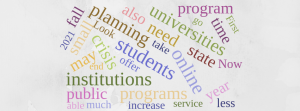The last three years have inflicted unprecedented costs on American higher education institutions, resulting in campus closures, refunded student fees, and a rapid shift to online learning—all as declining state support continues to undermine budgets. According to a GatherContent study, most universities are still grappling with legacy technologies while consolidating data across multiple silos. These trends have continued to worsen issues that existed in higher ed prior to 2020, turning cracks into chasms and leaving challenged colleges and universities with the daunting task of using technology to help effectively innovate and differentiate their institution’s value proposition.
“Digital Transformation” Won’t Save Higher Education
Before 2020, higher education was faced with increasing financial challenges caused by declining demographics, a dwindling international student base, and numerous other issues. The COVID-19 crisis forced schools to transition their spring semesters online very quickly. Technology proved not only useful but vital for them to survive until the fall semester. It seems that digital transformation has now become less of an “if” and more of a “when” for higher education, something essential for all but the largest organizations that are likely already utilizing the technology.
Canvas Implementation Best Practices & Pitfalls
As the higher education industry and the rest of the world are in the process of transitioning their face-to-face operations to remote, one thing is becoming abundantly clear: more colleges and universities are looking to upgrade their current learning management systems to something more modern, easier to use, and outfitted to help their institution excel in the post-COVID-19 world.
Effective Strategic Planning in a Time of Crisis
Early this year, we at Optimal Campus began thinking about posting a series of blogs focused on what many perceived as a crisis in higher education. Shifting demographics of potential students, rising costs, challenges to the value of higher education, and academic inertia placed higher education at a crossroads. Many were arguing, and we agreed, that, without fundamental changes, the current system of higher education in the United States would be unable to survive. And then COVID-19 happened!
Too Many Buildings, Not Enough Bandwidth
The COVID-19 pandemic has resulted in numerous immediate changes in higher education—online education only, closed campuses, remote work for faculty and staff. While many may hope these changes are temporary and things will go back to the way they were, that is quite likely not what will happen. Pressures have been building for several years to move more courses and programs online. Although many institutions already offer some online learning, it has not been without resistance from various stakeholders, especially faculty.




